Managing in a Time of Great Change
by Peter Drucker — his other books

#Note the number of books about Drucker ↓

My life as a knowledge worker
Drucker: a political or social ecologist ↑ ↓
“I am not a ‘theoretician’;
through my consulting practice
I am in daily touch with
the concrete opportunities and problems
of a fairly large number of institutions,
foremost among them businesses
but also hospitals, government agencies
and public-service institutions
such as museums and universities.
And I am working with such institutions
on several continents:
North America, including Canada and Mexico;
Latin America; Europe;
Japan and South East Asia.
Still, a consultant is at one remove
from the day-today practice —
that is both his strength
and his weakness.
And so my viewpoint
tends more to be that of an outsider.”
broad worldview ↑
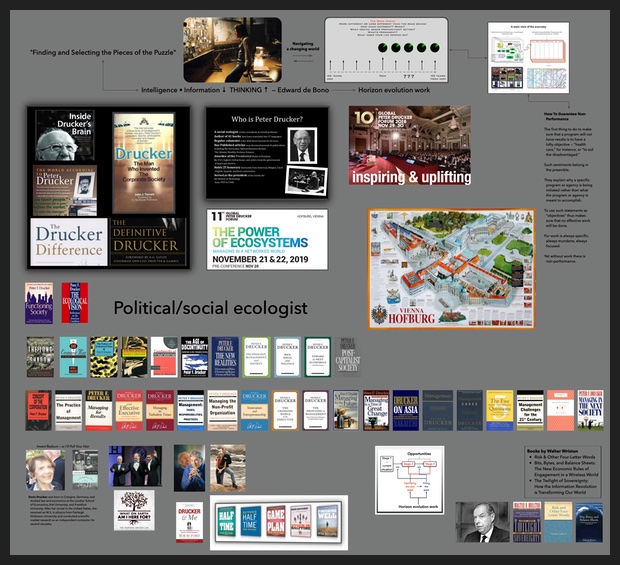
#pdw larger ↑ ::: Books by Peter Drucker ::: Rick Warren + Drucker
Books by Bob Buford and Walter Wriston
Global Peter Drucker Forum ::: Charles Handy — Starting small fires
Post-capitalist executive ↑

Learning to Learn (ecological awareness ::: operacy)
The MEMO they don’t want you to see

See rlaexp.com initial bread-crumb trail — toward the
end of this page — for a site “overview”
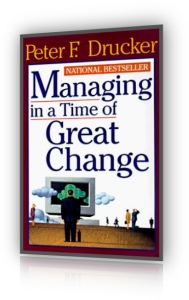
Amazon link: Managing in a Time of Great Change
See about management

Preface
All the pieces in this book—two interviews, one at the beginning and one at the end, and twenty-five chapters in between—have one common theme, despite their apparent diversity.
They all deal with changes that have already irreversibly happened.
They therefore deal with changes on which executives can—indeed must—take action.
None of the pieces in this book attempts to predict the future.
All deal with what executives can do—have to do—to make the future.
It is not so very difficult to predict the future.
It is only pointless.
Many futurologists have high batting averages—the way they measure themselves and are commonly measured.
They do a good job foretelling some things.
But always far more important are the fundamental changes that happened though no one predicted them or could possibly have predicted them.
Looking back ten years today, no one in 1985 predicted—or could have predicted—that the establishment of the European Economic Community would not release explosive economic growth in Europe but would, on the contrary, usher in a decade of economic stagnation and petty bickering.
As a result, the Unified Europe of 1995 is actually weaker in the world economy than was the fractured Europe of 1985; No one, ten years ago, predicted—or could have predicted—the explosive economic growth of mainland China, a growth that came despite rather than because of its government policies.
No one predicted the emergence of the 55 million overseas Chinese as the new economic superpower.
No one ten years ago could have predicted that the biggest impact of the Information Revolution on business would be a radical rethinking and restructuring of the oldest information system—and one that apparently was ossified in every joint and tissue—the accounting model of the “bean counters.”
But equally important: one cannot make decisions for the future.
Decisions are commitments to action.
And actions are always in the present, and in the present only.
But actions in the present are also the one and only way to make the future.
Executives are paid to execute—that is, to take effective action.
That they can only do in contemplation of the present, and by exploiting the changes that have already happened.
This book starts out with the executive’s job, that is, with management.
What has already happened in the world of executives that puts into question—or perhaps even makes obsolete—the assumptions, rules, and practices that worked these last forty years and that therefore have been automatically taken for granted.
The book then proceeds to look at the implications of one particular fundamental change in management, economy, and society: the emergence of information as the executive’s key resource and as the organization’s skeleton.
The premise of this part of the book is the old adage that either you are the tool’s master or you are its servant.
What do executives have to learn to be masters of the new tool?
Then this book moves out of the executive’s job and organizations and moves into markets and into a world economy in which there are new power centers, new growth markets, new growth industries.
In its last section the book analyzes the changes in society and government—the biggest changes, perhaps, in this Century of Social Transformations, in which government has been both a great success and the ultimate failure.
Only thirty—perhaps even only twenty—years ago it was often said that while there were a great many more managers and executives than there had been in the twenties (let alone before the First World War), most of them were doing pretty much what their predecessors had done and in pretty much the same way.
No one would say that anymore for today’s managers and executives.
But if there is one thing that is certain today it is that tomorrow’s managers and executives will do things that are even more different from what today’s managers and executives do.
And they will do them even more differently.
To enable today’s executives to be ahead of this different tomorrow—indeed to make it their tomorrow—is the aim of this book.
—Peter F. Drucker
Claremont, California
May 1995

- Managing in a Time of Great Change
- Preface
- Interview: The Post-Capitalist Executive
- Management
- The theory of the business
- Planning for uncertainty
- The five deadly business sins
- Worship of high profit margins and of “premium pricing.”
- Mispricing a new product by charging “what the market will bear.”
- Cost-driven pricing rather than price-led costing
- Slaughtering tomorrow’s opportunity on the altar of yesterday
- Feeding problems and starving opportunities
- Managing the family business
- Six rules for presidents
- Managing in the network society
- The information-based organization
- The economy
- Trade lessons from the world economy
- The U.S. economy’s power shift
- Where the new markets are
- The Pacific Rim and the world economy
- China’s growth markets
- The end of Japan, Inc.?
- A weak dollar strengthens Japan
- The new superpower: The overseas Chinese
- The society
- Conclusion

It Profits Us to Strengthen Nonprofits
America needs a new social priority: to triple the productivity of the nonprofits and to double the share of gross personal income—now just below 3 percent—they collect as donations.
Otherwise the country faces, only a few years out, social polarization.
Federal, state, and local governments will have to retrench sharply, no matter who is in office.
Moreover, government has proved incompetent at solving social problems.
Virtually every success we have scored has been achieved by nonprofits.
The great advances in health and longevity have been sponsored, directed, and in large part financed by such nonprofits as the American Heart Association and the American Mental Health Association.
Whatever results there are in the rehabilitation of addicts we owe to such nonprofits as Alcoholics Anonymous, the Salvation Army, and the Samaritans.
The schools in which inner-city minority children learn the most are parochial schools and those sponsored by some Urban League chapters.
The first group to provide food and shelter to the Kurds fleeing from Saddam last spring was an American nonprofit, the International Rescue Committee.
Many of the most heartening successes are being scored by small, local organizations.
One example would be the tiny Judson Center in Royal Oak, Michigan—an industrial suburb of Detroit—gets black women and their families off welfare while simultaneously getting severely handicapped children out of institutions and back into society.
Judson trains carefully picked welfare mothers to raise in their homes, for a modest salary, two or three crippled or emotionally disturbed kids.
The rehabilitation rate for the welfare mothers is close to 100 percent, with many of them in five years or so moving into employment as rehabilitation workers.
The rehabilitation rate for the children, who otherwise would be condemned to lifetime institutional confinement, is about 50 percent; and every one of these kids had been given up on as hopeless.
The nonprofits spend far less for results than governments spend for failures.
The cost per pupil in the New York Archdiocese’s parochial schools—70 percent of whose students stay in school, stay off the streets, and graduate with high literacy and salable-skills—is about half that in New York City’s failing public schools.
Two-thirds of the first-offenders paroled in Florida into the custody of the Salvation Army are “permanently” rehabilitated—they are not indicted for another crime for at least six years.
Were they to go to prison, two-thirds would become habitual criminals.
Yet a prisoner costs at least twice as much per year as a parolee in the custody of the Salvation Army.
The Judson Center saves the state of Michigan $100,000 a year for each welfare mother and her charges—one-third in welfare costs and two-thirds in the costs of keeping the children in institutions.
Though the majority of the students in private colleges and universities get some sort of financial aid, their parents still pay more than do the parents of students in state universities and colleges.
But the state-university student’s education actually costs a good deal more than (in some states twice as much as) that of the student in a private nonprofit institution—with the difference paid by the taxpayer.
The nonprofits have the potential to become America’s social sector-equal in importance to the public sector of government and the private sector of business.
The delivery system is already in place: There are now some 900,000 nonprofits, the great majority close to the problems of their communities.
And about 30,000 of them came into being in 1990 (the latest year for which figures are available)—practically all dedicated to local action on one problem: tutoring minority children; furnishing ombudsmen for patients in the local hospital; helping immigrants through government red tape.
Where twenty years ago the American middle class thought it had done its social duty by writing a check, it increasingly commits itself to active doing as well.
According to the best available statistics, there are now some 90 million Americans—one out of every two adults—working as “volunteers” in nonprofits for three hours a week on average; the nonprofits have become America’s largest “employer.”
Increasingly these volunteers do not look upon their work as charity; they see it as a parallel career to their paid jobs and insist on being trained, on being held accountable for results and performance, and on career opportunities for advancement to professional and managerial—though still unpaid—positions in the nonprofit.
Above all, they see in volunteer work access to achievement, to effectiveness, to self-fulfillment, indeed to meaningful citizenship.
And for this reason there is more demand for well-structured volunteer jobs than there are positions to fill.
Some observers (such as Brian O’Connell, head of Independent Sector, the national association of the large nonprofits) believe that, within ten years, two-thirds of American adults—120 million—will want to work as nonprofit volunteers for five hours a week each, which would mean a doubling of the man- and womanpower available for nonprofit work.
And the nonprofits are becoming highly innovative.
When some friends and I founded the Peter F. Drucker Foundation for NonProfit Management a year ago, we planned as our first public event a $25,000 award for the best innovation that would “create a significant new dimension of nonprofit performance.”
We hoped to receive 40 applications.
We received 809—and most were deserving of a prize.
The actual award went to the Judson Center, but the big nonprofits are as innovative as the small fry in many cases.
With several billion dollars in revenue, Family Service America—headquartered in Milwaukee—has become bigger than a good many Fortune 500 companies; it now is probably the biggest American nonprofit next to the Red Cross.
It has achieved its phenomenal growth in part through contracting with large employers such as General Motors to help employee families with such problems as addiction or the emotional disorders of adolescent children.
For the nonprofits’ potential to become reality, three things are needed.
First, the average nonprofit must manage itself as well as the best-managed ones do.
The majority still believe that good intentions and a pure heart are all that are needed.
They do not yet see themselves as accountable for performance and results.
And far too many splinter their efforts or waste them on nonproblems and on activities that would be done better—and more cheaply—by a business.
Second, nonprofits have to learn how to raise money.
The American public has not become less generous—there is little evidence of the “compassion fatigue” nonprofit people talk about.
In fact, giving has been going up quite sharply these past few years—from 2.5 percent of personal income to 2.9 percent.
Unfortunately, a great many nonprofits still believe that the way to get money is to hawk needs.
But the American public gives for results.
It no longer gives to “charity”; it “buys in.”
Of the charitable appeals most of us get in the mail every week, usually just one talks of results—the one that gets our check.
The nonprofits will have to get the additional money they need primarily from individuals—as they always have.
Even if there is government money—mainly via vouchers, I expect—and money from companies, they can supply only a fraction of what is needed.
Finally, we need a change in the attitude of government and government bureaucracies.
President Bush has spoken glowingly of the importance of the nonprofits as the “thousand points of light.”
If he really believes this, he should propose allowing taxpayers to deduct $1.10 for each dollar they give to nonprofits as a cash donation.
This would solve the nonprofits’ money problems at once.
It also could cut government deficits in the not-so-very-long run-for a well-managed nonprofit gets at least twice the bang out of each buck that a government agency does.
Some of the voucher programs already enacted cut public school budgets, since some of the district’s per-pupil spending moves with the child into the private sector.
Instead of such a policy, however, we have the IRS making one move after the other to penalize and to curtail donations to nonprofits—and the tax collectors of the big states are all doing the same.
Each of these moves is presented as “closing a tax loophole”; in fact, none has yielded a penny of additional revenue and none is likely to do so.
The real motivation for such actions is the bureaucracy’s hostility to the nonprofits—not too different from the bureaucracy’s hostility to markets and private enterprise in the former Communist countries.
The success of the nonprofits undermines the bureaucracy’s power and denies its ideology.
Worse, the bureaucracy cannot admit that the nonprofits succeed where governments fail.
What is needed, therefore, is a public policy that establishes the nonprofits as the country’s first line of attack on its social problems.
In my 1969 book The Age of Discontinuity, I first proposed “privatization,” only to have every reviewer tell me that it would never happen.
Now, of course, privatization is widely seen as the cure for modern economies mismanaged by socialist bureaucracies.
We now need to learn that “nonprofitization” may for modern societies he the way out of mismanagement by welfare bureaucracies.
[1991]


The following ↓ is a condensed strategic brainscape that can be explored and modified to fit a user’s needs
The concepts and links below ↓ are …
major foundations ↓ for future directed decisionS
aimed at navigating
a world constantly moving toward unimagined futureS ↓

YouTube: The History of the World in Two Hours
— beginning with the industrial revolution ↑ ↓
Management and the World’s Work
↑ In less than 150 years, management ↑ has transformed
the social and economic fabric of the world’s developed countries …
“Your thinking, choices, decisions are determined by
what you have seen” edb

Take responsibility for yourself and
don’t depend on any one organization ↑ ↓ (bread-crumb trailS below)
We can only work on the thingS on our mental radar ↑ at a point in time ↓
About time ↓ The future that has already happened
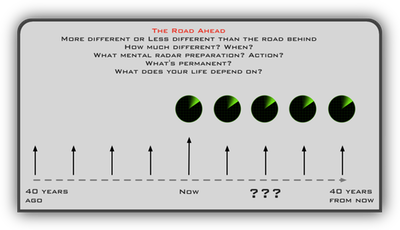
The economic and social health of our world
depends on
our capacity to navigate unimagined futureS
(and not be prisoners of the past)
The assumption that tomorrow is going to be
an extrapolation of yesterday sabotages the future — an
organization’s, a community’s and a nation’s future.
The assumption ↑ sabotages future generations — your children’s,
your grandchildren’s and your great grandchildren’s — in
spite of what the politicians say …
The vast majority of organization and political power structures
are engaged in this ↑ futile mind-set …
while rationalizing the evidence
The future is unpredictable and that means
it ain’t going to be like today
(which was designed & produced yesterday)
The capacity to navigate is governed by what’s between our ears ↑ ↓

When we are involved in doing something ↑
it is extremely difficult to navigate
and very easy to become a prisoner of the past.
We need to maintain a pre-thought ↓
systematic approach to work and work approach ↓
Click on either side of the image below to see a larger view
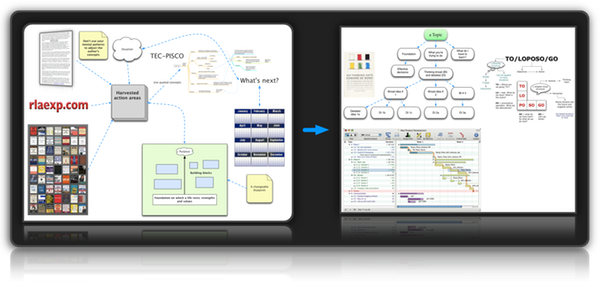
based on reality →
the non-linearity of time and events
and the unpredictability of the future
with its unimagined natureS. ↓ ↑
(It’s just a matter of time before we can’t get to the future
from where we are presently)
Foundations and opportunities ::: larger view ↓
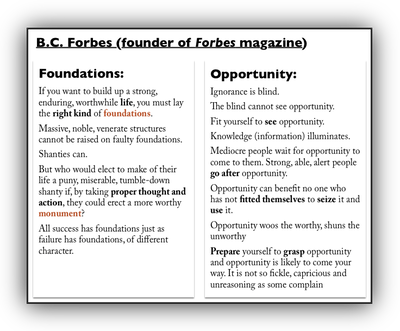
Intelligence and behavior ↑ ↓ ← Niccolò Machiavelli ↑ ↓
Political ecologists believe that the traditional disciplines define fairly narrow and limited tools rather than meaningful and self-contained areas of knowledge, action, and events … continue
❡ ❡ ❡
Foundational ↑ Books → The Lessons of History — unfolding realities (The New Pluralism → in Landmarks of Tomorrow ::: in Frontiers of Management ::: How Can Government Function? ::: the need for a political and social theory ::: toward a theory of organizations then un-centralizing plus victims of success) ::: The Essential Drucker — your horizons? ::: Textbook of Wisdom — conceptual vision and imagination tools ::: The Daily Drucker — conceptual breadth ::: Management Cases (Revised Edition) see chapter titles for examples of “named” situations …

What do these ideas, concepts, horizons mean for me? continue

Society of Organizations
“Corporations once built to last like pyramids
are now more like tents.
Tomorrow they’re gone or in turmoil.”

“The failure to understand the nature, function, and
purpose of business enterprise” Chapter 9, Management Revised Edition
“The customer never buys ↑ what you think you sell.
And you don’t know it.
That’s why it’s so difficult to differentiate yourself.” Druckerism
“People in any organization are always attached to the obsolete —
the things that should have worked but did not,
the things that once were productive and no longer are.” Druckerism
Why Peter Drucker Distrusted Facts (HBR blog) and here
Best people working on the wrong things continue
Conditions for survival
Going outside
Making the future — a chance for survival ↑
“For what should America’s new owners, the pension funds,
hold corporate management accountable?” and
“Rather, they maximize the wealth-producing capacity of the enterprise”
Search for the quotes above here
Successful careerS are not planned ↑ here and ↓
What do these issues, these challenges mean for me & … — an alternative
Exploration paths → The memo they don’t want you to see ::: Peter Drucker — top of the food chain ::: Work life foundations (links to Managing Oneself) ::: A century of social transformation ::: Post-capitalist executive interview ::: Allocating your life ::: What executives should remember ::: What makes an effective executive? ::: Innovation ::: Patriotism is not enough → citizenship is needed ::: Drucker’s “Time” and “Toward tomorrowS” books ::: Concepts (a WIP) ::: Site map a.k.a. brainscape, thoughtscape, timescape
Just reading ↑ is not enough, harvesting and action thinking are needed … continue
Information ↑ is not enough, thinking ↓ is needed … first then next + critical thinking
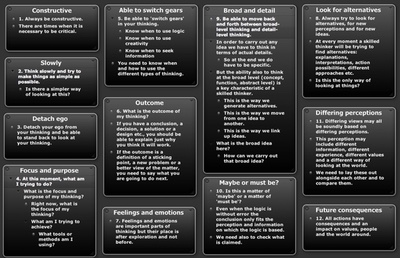
Larger view of thinking principles ↑ Text version ↑ :::
Always be constructive ↑ What additional thinking is needed?
Initially and absolutely needed: the willingness and capacity to
regularly look outside of current mental involvements continue
bread-crumb trail end

Peter Drucker: Conceptual Resources
The Über Mentor
A political / social ecologist
a different way of seeing and thinking about
the big picture
— lead to his top-of-the-food-chain reputation
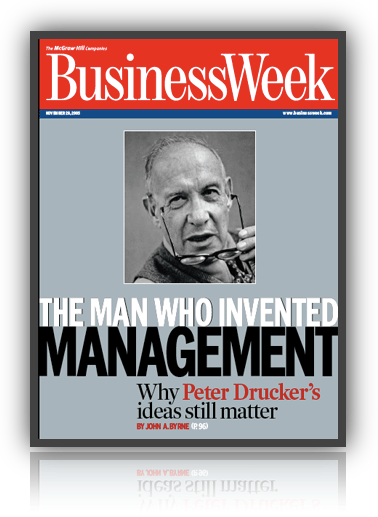
about Management (a shock to the system)
“I am not a ‘theoretician’; through my consulting practice I am in daily touch with the concrete opportunities and problems of a fairly large number of institutions, foremost among them businesses but also hospitals, government agencies and public-service institutions such as museums and universities.
And I am working with such institutions on several continents: North America, including Canada and Mexico; Latin America; Europe; Japan and South East Asia.” — PFD

List of his books
Large combined outline of Drucker’s books — useful for topic searching.

“High tech is living in the nineteenth century,
the pre-management world.
They believe that people pay for technology.
They have a romance with technology.
But people don't pay for technology:
they pay for what they get out of technology.” —
The Frontiers of Management

|
![]()
